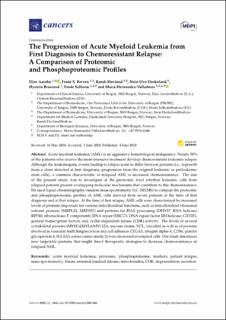| dc.contributor.author | Aasebø, Elise | |
| dc.contributor.author | Berven, Frode | |
| dc.contributor.author | Hovland, Randi | |
| dc.contributor.author | Doskeland, Stein Ove | |
| dc.contributor.author | Bruserud, Øystein | |
| dc.contributor.author | Selheim, Frode | |
| dc.contributor.author | Hernandez-Valladares, Maria | |
| dc.date.accessioned | 2021-05-18T12:18:21Z | |
| dc.date.available | 2021-05-18T12:18:21Z | |
| dc.date.created | 2020-11-26T12:40:16Z | |
| dc.date.issued | 2020 | |
| dc.Published | Cancers. 2020, 12 (6), 1-13. | |
| dc.identifier.issn | 2072-6694 | |
| dc.identifier.uri | https://hdl.handle.net/11250/2755484 | |
| dc.description.abstract | Acute myeloid leukemia (AML) is an aggressive hematological malignancy. Nearly 50% of the patients who receive the most intensive treatment develop chemoresistant leukemia relapse. Although the leukemogenic events leading to relapse seem to differ between patients (i.e., regrowth from a clone detected at first diagnosis, progression from the original leukemic or preleukemic stem cells), a common characteristic of relapsed AML is increased chemoresistance. The aim of the present study was to investigate at the proteomic level whether leukemic cells from relapsed patients present overlapping molecular mechanisms that contribute to this chemoresistance. We used liquid chromatography–tandem mass spectrometry (LC–MS/MS) to compare the proteomic and phosphoproteomic profiles of AML cells derived from seven patients at the time of first diagnosis and at first relapse. At the time of first relapse, AML cells were characterized by increased levels of proteins important for various mitochondrial functions, such as mitochondrial ribosomal subunit proteins (MRPL21, MRPS37) and proteins for RNA processing (DHX37, RNA helicase; RPP40, ribonuclease P component), DNA repair (ERCC3, DNA repair factor IIH helicase; GTF2F1, general transcription factor), and cyclin-dependent kinase (CDK) activity. The levels of several cytoskeletal proteins (MYH14/MYL6/MYL12A, myosin chains; VCL, vinculin) as well as of proteins involved in vesicular trafficking/secretion and cell adhesion (ITGAX, integrin alpha-X; CD36, platelet glycoprotein 4; SLC2A3, solute carrier family 2) were decreased in relapsed cells. Our study introduces new targetable proteins that might direct therapeutic strategies to decrease chemoresistance in relapsed AML. | en_US |
| dc.language.iso | eng | en_US |
| dc.publisher | MDPI | en_US |
| dc.rights | Navngivelse 4.0 Internasjonal | * |
| dc.rights.uri | http://creativecommons.org/licenses/by/4.0/deed.no | * |
| dc.title | The progression of acute myeloid leukemia from first diagnosis to chemoresistant relapse: A comparison of proteomic and phosphoproteomic profiles | en_US |
| dc.type | Journal article | en_US |
| dc.type | Peer reviewed | en_US |
| dc.description.version | publishedVersion | en_US |
| dc.rights.holder | Copyright the authors. | en_US |
| dc.source.articlenumber | 1466 | en_US |
| cristin.ispublished | true | |
| cristin.fulltext | original | |
| cristin.qualitycode | 1 | |
| dc.identifier.doi | 10.3390/cancers12061466 | |
| dc.identifier.cristin | 1852822 | |
| dc.source.journal | Cancers | en_US |
| dc.source.40 | 12 | |
| dc.source.14 | 6 | |
| dc.identifier.citation | Cancers. 2020, 12 (6), 1466. | en_US |
| dc.source.volume | 12 | en_US |
| dc.source.issue | 6 | en_US |

